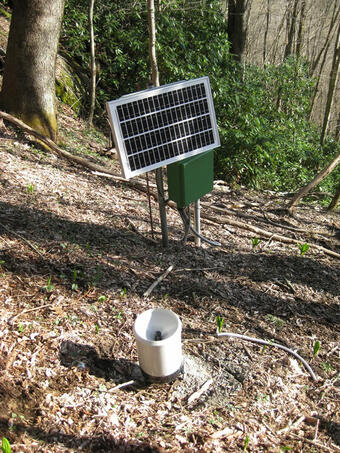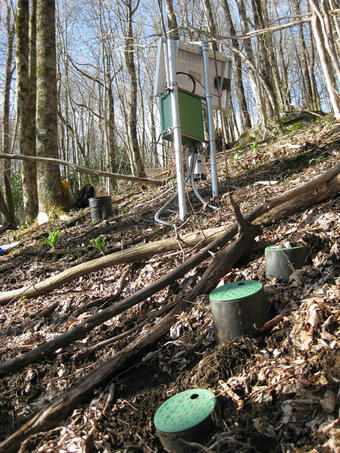Mooney Gap, Coweeta Experimental Forest, North Carolina Active
The USGS and its cooperators have installed instruments in a steep hillside about 16 km southeast of Otto, NC in the Coweeta Experimental Forest.
Recent Conditions
The Mooney Gap station requires maintenance and is not currently collecting data. Instruments were installed in the fall of 2013 and are used to monitor and detect changes in local conditions, including
- Rainfall
- Ground Water Pressure
- Soil Water Content
- Soil Temperature
- Battery Voltage
Project Background
Landslides in western North Carolina impact people and the environment and are commonly induced by intense or prolonged rainfall associated with strong storms. For example, in September of 2004 heavy rainfall from two hurricanes, Frances and Ivan, induced thousands of landslides over a large part of western North Carolina.
The USGS and its cooperators have installed instruments in a steep hillside about 16 km southeast of Otto, NC in the Coweeta Experimental Forest. Data collection at this site supports research on hydrologic factors that control landslide initiation. In many landslide-prone hillsides, infiltration of water from rainfall or snowmelt increases ground-water pressures. These elevated pressures can, in turn, induce landslide movement.



The USGS and its cooperators have installed instruments in a steep hillside about 16 km southeast of Otto, NC in the Coweeta Experimental Forest.
Recent Conditions
The Mooney Gap station requires maintenance and is not currently collecting data. Instruments were installed in the fall of 2013 and are used to monitor and detect changes in local conditions, including
- Rainfall
- Ground Water Pressure
- Soil Water Content
- Soil Temperature
- Battery Voltage
Project Background
Landslides in western North Carolina impact people and the environment and are commonly induced by intense or prolonged rainfall associated with strong storms. For example, in September of 2004 heavy rainfall from two hurricanes, Frances and Ivan, induced thousands of landslides over a large part of western North Carolina.
The USGS and its cooperators have installed instruments in a steep hillside about 16 km southeast of Otto, NC in the Coweeta Experimental Forest. Data collection at this site supports research on hydrologic factors that control landslide initiation. In many landslide-prone hillsides, infiltration of water from rainfall or snowmelt increases ground-water pressures. These elevated pressures can, in turn, induce landslide movement.




